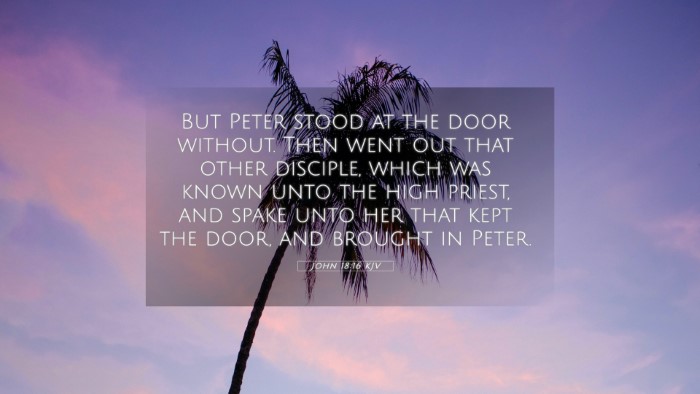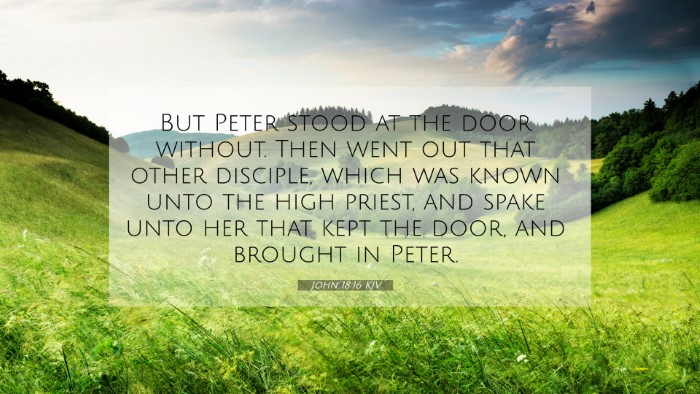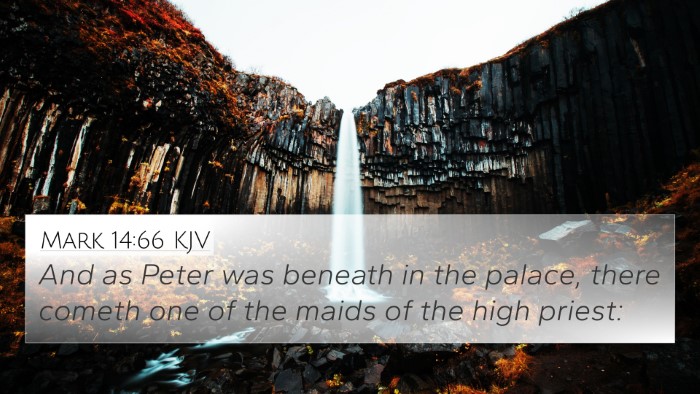Understanding John 18:16
John 18:16 states, "But Peter stood at the door without. Then went out that other disciple, which was known unto the high priest, and spake unto her that kept the door, and brought in Peter." This verse marks a pivotal moment in the narrative of Peter's denial of Jesus and reflects themes of access, loyalty, and the dynamics of discipleship.
Context and Significance
The events surrounding John 18:16 occur during the trial of Jesus following His arrest. The tension builds as Peter, one of Jesus' closest disciples, grapples with fear and identity while standing at the door of the high priest's courtyard. This verse illustrates both physical and relational barriers that the disciples faced and serves as a microcosm of the broader rejection of Christ.
Thematic Exploration
This verse evokes several themes central to the Gospel narrative:
- Access to Authority: Peter’s position at the door symbolizes the challenge of accessing power structures that oppose the gospel. The 'other disciple' is identified as someone known to the high priest, highlighting the importance of connections in navigating hostile environments.
- Loyalty and Fear: Peter's hesitance to openly associate with Jesus reveals the strain between loyalty and fear. This internal conflict remains a relatable struggle for many believers.
- The Role of Discipleship: The act of bringing Peter into the courtyard represents a moment of support amidst doubt, underscoring the importance of community within the Christian faith.
Commentary Insights
Various public domain commentaries provide rich insights into the meaning of John 18:16:
- Matthew Henry: Emphasizes the remarkable shift from Peter’s previously bold demeanor to his subsequent fearfulness. Henry suggests that Peter's entrance into the high priest's courtyard was both a moment of vulnerability and temptation.
- Albert Barnes: Notes the significance of the identity of 'the other disciple,' often believed to be John. Barnes asserts that this relationship enabled Peter's presence in the courtyard, reflecting the crucial support network among the disciples.
- Adam Clarke: Discusses the implications of Peter’s fear, suggesting that it represents the struggle of many Christians who face societal pressures. Clarke also points out the historical context of entrance protocols into the house of the high priest.
Cross-References
John 18:16 can be linked to various other Bible verses that illuminate its themes:
- Matthew 26:69-75: The account of Peter's denial highlights the fear and subsequent restoration of Peter’s identity.
- Luke 22:54-62: This passage provides a deeper insight into Peter’s denial and the emotional turmoil faced immediately after.
- Mark 14:66-72: This reference recounts the same event, emphasizing Peter's transformation from a bold follower to a frightened denier.
- John 13:38: Earlier, Jesus foretold Peter’s denial, establishing the narrative continuity and prophetic nature of this moment.
- Acts 4:13: A future reference where Peter stands boldly before authority, showcasing his journey from denial to empowerment.
- Romans 12:1-2: Links to the theme of sacrifice and the challenge of remaining steadfast in the face of societal pressures.
- 1 John 2:19: Engages with themes of true discipleship and the consequences of detachment from Christ.
Connecting Themes in Scripture
John 18:16 offers an opportunity for connecting themes throughout the Bible:
- Faith and Fear: The duality of Peter’s response resonates with many biblical characters, such as Gideon in Judges 6, who also faced fears before a divine calling.
- Community Support: The act of the 'other disciple' bringing Peter into the courtyard parallels the actions of Jonathan supporting David in 1 Samuel 18.
- Authority and Rejection: Reflects the broader narrative found in the prophets, particularly Jeremiah, who also faced rejection from his community.
Tools for Bible Cross-Referencing
For those studying the connections between biblical texts, consider utilizing various cross-reference tools such as:
- Bible Concordance: Helps locate themes and words across different passages.
- Cross-Reference Bible Study Guides: Offer structured ways to explore thematic connections.
- Comprehensive Bible Cross-Reference Materials: Provide extensive insights into interrelations among scriptures.
User Intent and Study Opportunities
For readers seeking to deepen their understanding of biblical connections, questions to explore might include:
- What verses are related to John 18:16?
- How do John 18:16 and Matthew 26:69-75 connect?
- What are the similarities between Peter’s fear in John 18:16 and other biblical characters in crisis?
Conclusion
John 18:16 serves as an essential passage in understanding the complexities of discipleship, fear, and the dynamics of relationships within the early Christian community. By studying this verse through the lens of cross-referencing and thematic connections throughout the Bible, readers can grasp a fuller sense of its meaning and implications in both historical and contemporary contexts.
Understanding the complexities of biblical narratives encourages deeper faith and reflection. Engage with the scriptures through thematic connections and cross-references as a means to enrich your spiritual journey.





